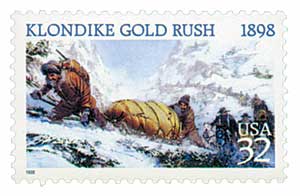
# 3235 - 1998 32c Klondike Gold Rush
1998 32¢ Klondike Gold Rush
City: Nome, AK
Quantity: 28,000,000
Printed By: Sterling Sommer for Ashton-Potter (USA) Ltd
Printing Method: Lithographed
Perforations: 11.1
Color: Multicolored
Klondike Gold Rush
The indigenous people in the area had long known of the existence of gold in the region, but they didn’t use it and didn’t search for it. When Russians and members of the Hudson’s Bay Company came to the area, they heard the rumors of gold but opted to focus on fur trading instead, because it provided quicker profits.
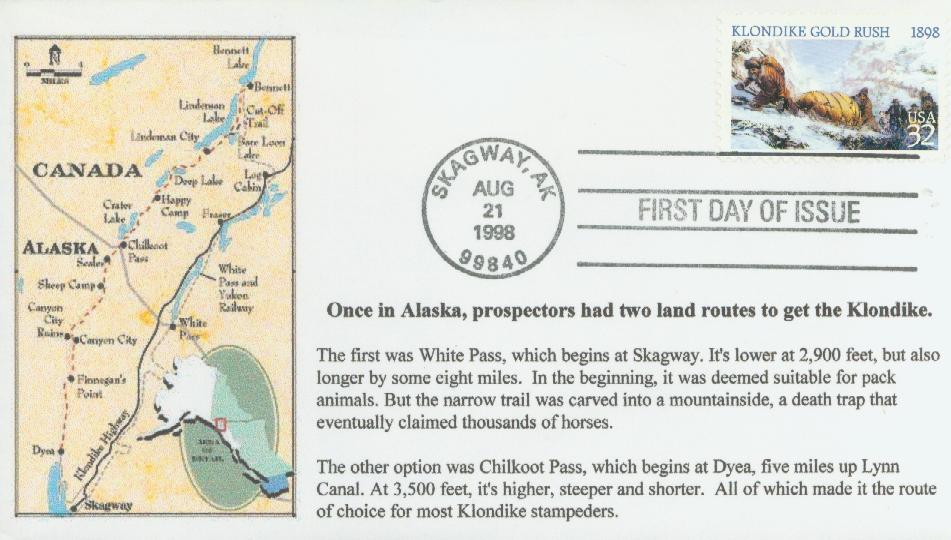
It wasn’t until the mid-to-late 1800s that American prospectors began to explore the area in search of gold. They established the Chilkoot and White Pass routes and reached the Yukon valley in 1870. Gold was found along the Yukon River in 1883 and in the Fortymile River in 1886. Also in 1886, small amounts of gold were unearthed in the Klondike River, but no claims were made. By the late 1880s, there were several hundred miners combing the Yukon valley in search of gold. With them came the establishment of mining camps and small towns, though some were large enough to include saloons, opera houses, schools, and libraries.
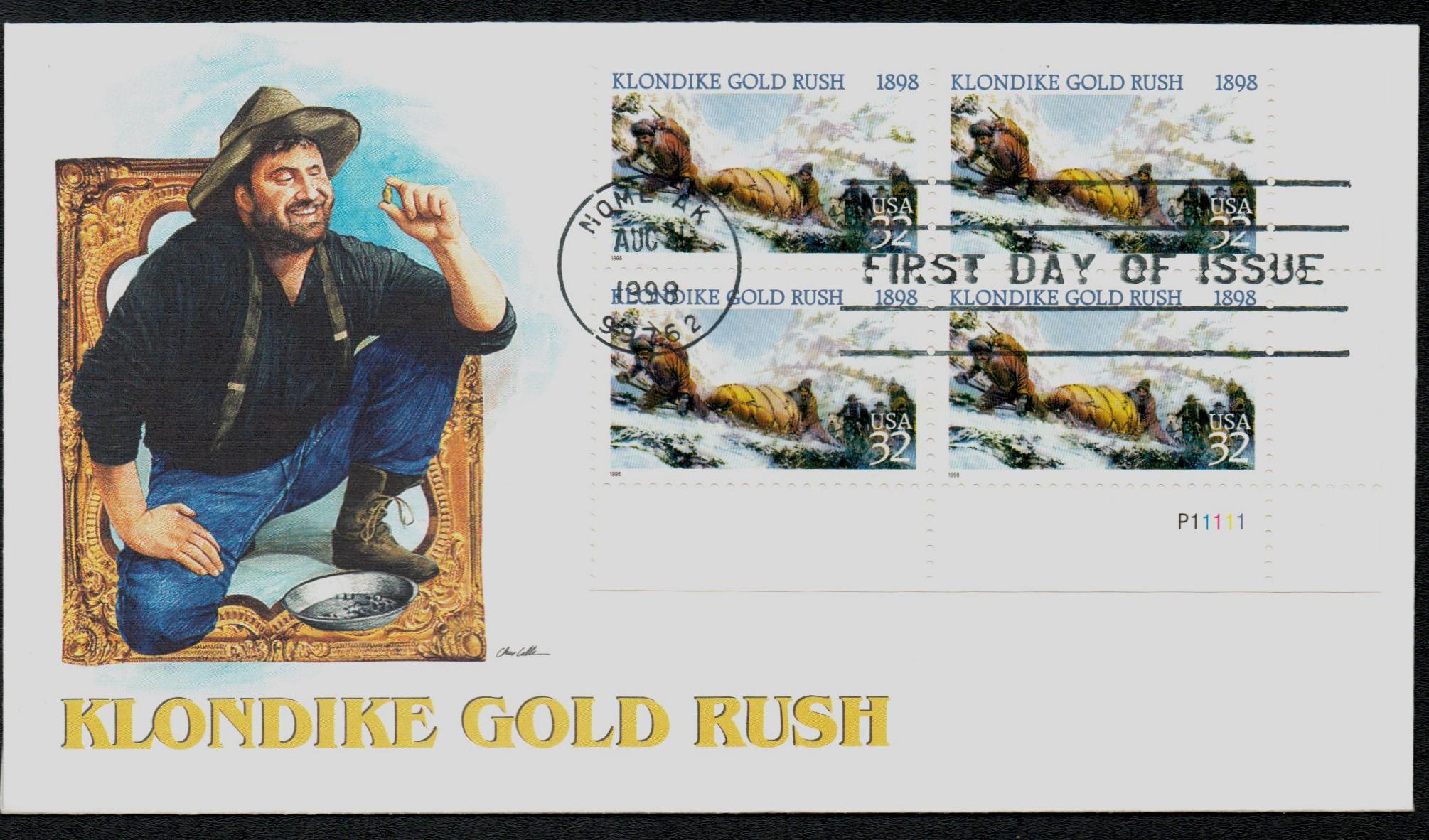
On August 16, 1896, a party headed by American prospector George Carmack, which included his wife Kate, her brother Skookum Jim, and their nephew Dawson Charlie, was searching the area south of the Klondike River. Along the way, Canadian prospector Robert Henderson suggested they look along Rabbit Creek (later called Bonanza Creek). On August 16, George or Jim found gold in that creek, marking the start of the Klondike Gold Rush. George quickly claimed four strips of ground along the river and news spread through the nearby camps. By the end of the month, all of Bonanza Creek had been claimed.
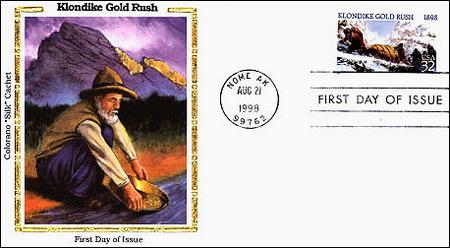
Another prospector soon explored another creek that fed into Bonanza and it was named Eldorado. That creek would prove to be even richer in gold. In the coming months, word continued to spread throughout the mining camps and prospectors loaded up their dog sleds to reach the area before all the land was claimed. Outside of the Yukon, few people knew of the exciting discoveries being made. The cold winter weather halted river traffic, so the first boats to carry out gold and stories didn’t leave until June 1897.
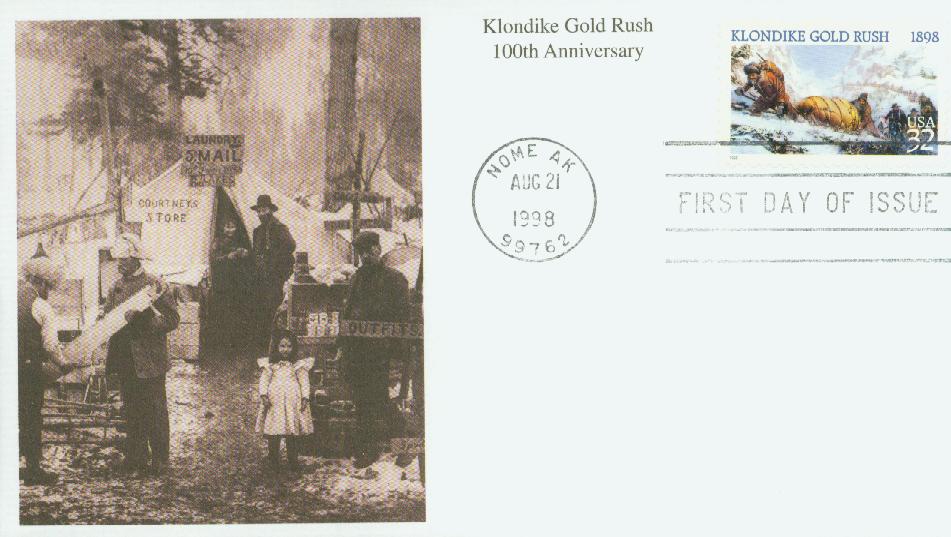
The first reports outside of the Yukon didn’t appear until July 15, 1897, when the first prospectors reached San Francisco. Early reports claimed that two of the arriving ships carried $1,139,000 in gold, though that turned out to be an underestimate. At the time, the US was in the middle of a financial recession, with several bank failures. Americans who had been affected by the crisis packed their belongings and began the long trek North.
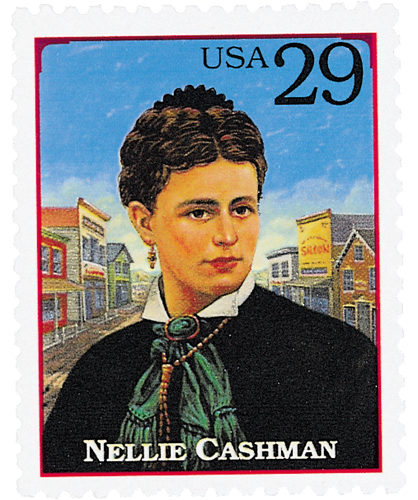
However, traveling to the Klondike region, located near the border between Canada and Alaska, was expensive and difficult. On average, the journey cost $1,500 per person. The most popular route was a five-day, 1,000-mile trip along the coast of British Columbia to Skagway, Alaska. From there, voyagers would cross the rugged Coast Mountains and 550 miles of wilderness to the goldfields. Tent stores sold food, tools, and other items to people along the trail.
Lasting only three years, the Klondike Gold Rush was the largest and most dramatic discovery of gold in American history. Historians estimate that the arrival of these miners spiked the population to nearly 40,000. Although not everyone was fortunate enough to find gold, many of these people were entrepreneurs that opened businesses and helped the economy.
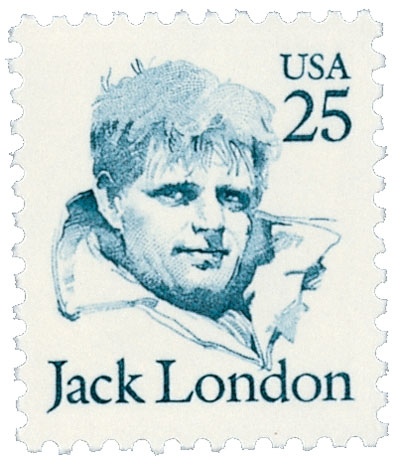
Between July and November 1898, the US mints in Seattle and San Francisco received $10 million in Klondike gold; in 1899, $16 million; and in 1900, $22 million. Over the next 50 years, the region produced $500 million dollars worth of gold. By 1900, the frenzied gold rush had ended. The construction of a railroad allowed large mining companies to take over, and most prospectors moved on to gold rushes in other states.
1998 32¢ Klondike Gold Rush
City: Nome, AK
Quantity: 28,000,000
Printed By: Sterling Sommer for Ashton-Potter (USA) Ltd
Printing Method: Lithographed
Perforations: 11.1
Color: Multicolored
Klondike Gold Rush
The indigenous people in the area had long known of the existence of gold in the region, but they didn’t use it and didn’t search for it. When Russians and members of the Hudson’s Bay Company came to the area, they heard the rumors of gold but opted to focus on fur trading instead, because it provided quicker profits.

It wasn’t until the mid-to-late 1800s that American prospectors began to explore the area in search of gold. They established the Chilkoot and White Pass routes and reached the Yukon valley in 1870. Gold was found along the Yukon River in 1883 and in the Fortymile River in 1886. Also in 1886, small amounts of gold were unearthed in the Klondike River, but no claims were made. By the late 1880s, there were several hundred miners combing the Yukon valley in search of gold. With them came the establishment of mining camps and small towns, though some were large enough to include saloons, opera houses, schools, and libraries.

On August 16, 1896, a party headed by American prospector George Carmack, which included his wife Kate, her brother Skookum Jim, and their nephew Dawson Charlie, was searching the area south of the Klondike River. Along the way, Canadian prospector Robert Henderson suggested they look along Rabbit Creek (later called Bonanza Creek). On August 16, George or Jim found gold in that creek, marking the start of the Klondike Gold Rush. George quickly claimed four strips of ground along the river and news spread through the nearby camps. By the end of the month, all of Bonanza Creek had been claimed.

Another prospector soon explored another creek that fed into Bonanza and it was named Eldorado. That creek would prove to be even richer in gold. In the coming months, word continued to spread throughout the mining camps and prospectors loaded up their dog sleds to reach the area before all the land was claimed. Outside of the Yukon, few people knew of the exciting discoveries being made. The cold winter weather halted river traffic, so the first boats to carry out gold and stories didn’t leave until June 1897.

The first reports outside of the Yukon didn’t appear until July 15, 1897, when the first prospectors reached San Francisco. Early reports claimed that two of the arriving ships carried $1,139,000 in gold, though that turned out to be an underestimate. At the time, the US was in the middle of a financial recession, with several bank failures. Americans who had been affected by the crisis packed their belongings and began the long trek North.

However, traveling to the Klondike region, located near the border between Canada and Alaska, was expensive and difficult. On average, the journey cost $1,500 per person. The most popular route was a five-day, 1,000-mile trip along the coast of British Columbia to Skagway, Alaska. From there, voyagers would cross the rugged Coast Mountains and 550 miles of wilderness to the goldfields. Tent stores sold food, tools, and other items to people along the trail.
Lasting only three years, the Klondike Gold Rush was the largest and most dramatic discovery of gold in American history. Historians estimate that the arrival of these miners spiked the population to nearly 40,000. Although not everyone was fortunate enough to find gold, many of these people were entrepreneurs that opened businesses and helped the economy.

Between July and November 1898, the US mints in Seattle and San Francisco received $10 million in Klondike gold; in 1899, $16 million; and in 1900, $22 million. Over the next 50 years, the region produced $500 million dollars worth of gold. By 1900, the frenzied gold rush had ended. The construction of a railroad allowed large mining companies to take over, and most prospectors moved on to gold rushes in other states.












